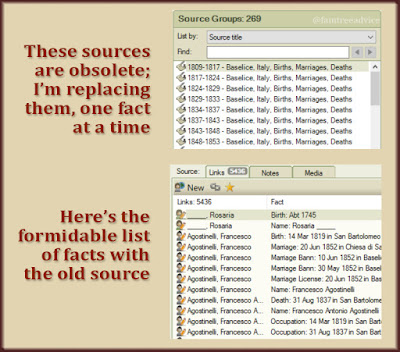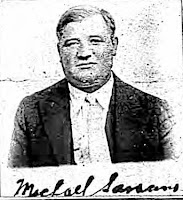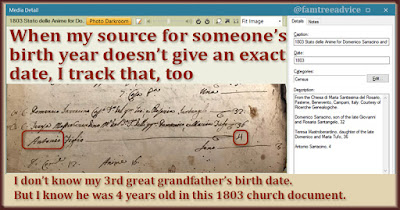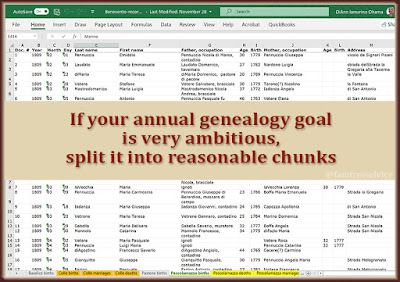Even with no cooperation, you can work a DNA match into your family tree.
One of my 2020 Genealogy Goals is to figure out my connection to at least 1 DNA match per month. Here's a breakdown of how I met this goal for January.
I bought an Ancestry DNA kit back in 2012. I have uploaded my raw DNA to a few other websites, but Ancestry DNA gives me the most robust tools. As I scroll down my match list, I can see the brief notes I added to people, like:
- descendant of Teofilo Iamarino (that's my great grandfather's brother)
- related thru Libera Maria Iamarino (that's another great grandfather's sister)
- related thru Nicola Leone (that's my grandfather's 1st cousin)
These notes make it easy to scan the list and find someone with a family tree but no note from me.
 |
| No tree, private tree, worthless tree. Why did they get a DNA test? |
My 1st candidate is a man with a 7-person tree, but only 4 names are not private. The facts are almost non-existent. But I recognize the my match's last name as being from my grandfather's hometown in Italy.
I don't know what year anyone in my match's family tree was born. So I searched for my match's exact name on Facebook. I found a man who is very likely him, based on our mutual friend. Having seen him in one photo, I can estimate he's about my age.
That gives me something to go on. I can assume his grandfather is from my grandfather's town and was born more than 100 years ago. There are 2 people in my collection of Italian vital records who could be the grandfather of my match.
But I can't go any further without writing to my match and hoping he replies. Let's move on.
My 2nd candidate is a woman with a 29-person family tree. Once again I recognize a couple of last names from my grandfather's Italian hometown.
Unfortunately this 29-person family tree makes very little sense. People are not connected to one another. There's a lack of maiden names. And the 2 last names I recognize don't have an obvious connection to my DNA match. I'm starting to lose hope.
Before I move on, I'll search my Italian vital records collection for people in the tree. One person from the tree might be the son of my 1st cousin 5 times removed, Liberantonia Iamarino. But I have no way to be sure.
The next few candidates have worthless trees. This is what happens when someone gets a DNA kit as a gift but doesn't care.
Finally, down in the 4th–6th cousin range, I see another familiar last name. (Grandpa's hometown has descendants EVERYWHERE!) His family tree has only 7 people, but it has what I really like: Italians born in the 1800s.
Sure enough, my DNA match's paternal grandfather is from Grandpa's town. I found his 1882 birth record and saw a note written in its column. It said this man married my DNA match's grandmother in 1904. That proves I've got the right birth record.
To turn this cousin into a solved DNA match, I've got to get his people into my tree. His grandfather Gennaro was born in 1882 to Ignazio and Costanza. Ignazio is not a common first name in the town, and that will help me. I searched my digital town folder and found his 1931 death record. I know it's him because he's still married to Costanza. Based on his age at death, I found his birth record. Then I found Ignazio's parents' (my match's 2nd great grandparents') 1843 marriage records.
 |
| While fitting this DNA match into my family tree, I discovered 4 of my 7th great grandparents! |
And that marriage is the key. The bride in 1843 (Costanza) is the daughter of my 5th great uncle, Francesco Saverio d'Emilia. Boo yah!
Now I can work my way down to my DNA match. I add my 1st cousin 5 times removed, Costanza Carmela Guilia d'Emilia, to my family tree. I add her husband and their son. Then I add his wife and their son. Then I add his son—my DNA match.
Solved: This DNA match is my 5th cousin once removed. I'll go back to add the details and attach the Italian document images. Then I'll contact my DNA match and point him to that part of my tree. Your DNA match is more likely to answer if you say "Here's your family" than if you ask "Who's your family?"
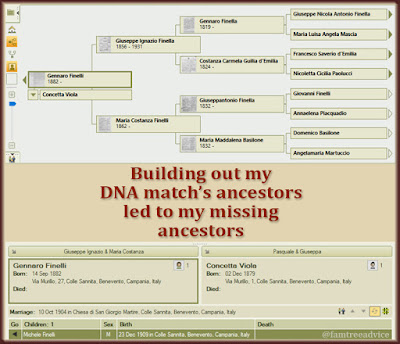 |
| This is why you work on your DNA match's family tree. |
As I told my husband the other day, anyone who's a DNA match to me is very lucky. I've got a big tree and the documents to make it bigger and bigger. The key to figuring out your DNA match's connection is familiarity. You've got to be very familiar with the last names in your family tree and in your towns. That's how I attack each match. I spot a last name (usually from Grandpa Iamarino's town), and I try to solve it.
That's my DNA genealogy goal for January. Time to tackle a different goal.
